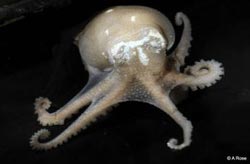Octopus' blue blood allows them to rule the waves!

The Antarctic octopod Pareledone charcoti photographed during the Polarstern cruise 2011 ANTXXVII/3. Credit: Armin Rose<br>
They manage to survive temperature habitats ranging from as low as -1.8°C to more than 30°C due to their ability to keep supplying oxygen to their body tissues. A new study, to be presented at the Society for Experimental Biology meeting on July 5, shows that a blue colored pigment, hemocyanin, in their blood, responsible for oxygen transport, crucially allows octopods to live in freezing temperatures.
Research by Michael Oellermann, Hans Pörtner and Felix Mark at the Alfred Wegener Institute for Polar and Marine Research in Germany, looked at how octopods are able to supply oxygen to tissues in freezing temperatures. The researchers compared the properties of blood pigment haemocyanin, responsible for oxygen transport, of Antarctic, Temperate and Warm-Adapted octopods.
The researchers found that the forms of haemocyanin of the Antarctic octopod Pareledone charcoti, are genetically and functionally different from the temperate and warmer climate octopods, facilitating oxygen release at sub-zero temperatures.
Michael Oellermann said: “Octopods are mainly local non-migratory species that move by crawling and have only short life stages in which they inhabit the water column. They are therefore mostly unable to migrate away from or escape “bad” environmental conditions, which exposes them to higher adaptive pressure to deal with these conditions. Our finding shows a crucial physiological adaption in cold environments that allows octopods to sustain an aerobic life.”
Media Contact
More Information:
http://www.sebiology.orgAll latest news from the category: Life Sciences and Chemistry
Articles and reports from the Life Sciences and chemistry area deal with applied and basic research into modern biology, chemistry and human medicine.
Valuable information can be found on a range of life sciences fields including bacteriology, biochemistry, bionics, bioinformatics, biophysics, biotechnology, genetics, geobotany, human biology, marine biology, microbiology, molecular biology, cellular biology, zoology, bioinorganic chemistry, microchemistry and environmental chemistry.
Newest articles

Webb captures top of iconic horsehead nebula in unprecedented detail
NASA’s James Webb Space Telescope has captured the sharpest infrared images to date of a zoomed-in portion of one of the most distinctive objects in our skies, the Horsehead Nebula….

Cost-effective, high-capacity, and cyclable lithium-ion battery cathodes
Charge-recharge cycling of lithium-superrich iron oxide, a cost-effective and high-capacity cathode for new-generation lithium-ion batteries, can be greatly improved by doping with readily available mineral elements. The energy capacity and…

Novel genetic plant regeneration approach
…without the application of phytohormones. Researchers develop a novel plant regeneration approach by modulating the expression of genes that control plant cell differentiation. For ages now, plants have been the…





















